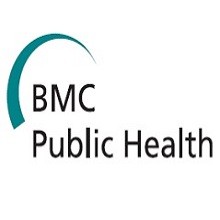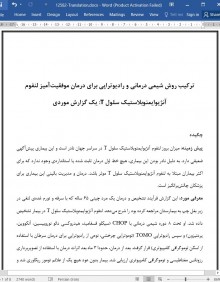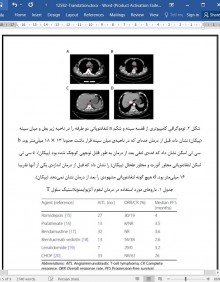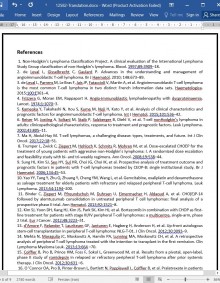
دانلود مقاله ترکیب روش شیمی درمانی و رادیوتراپی برای درمان موفقیت آمیز لنفوم آنژیوایمنوبلاستیک سلول T
چکیده
پیش زمینه: میزان بروز لنفوم آنژیوایمنوبلاستیک سلول T در سراسر جهان نادر است و این بیماری پیش آگهی ضعیفی دارد. به دلیل نادر بودن این بیماری، هیچ خط اول درمان ثابت شده یا استانداردی وجود ندارد که برای اکثر بیماران مبتلا به لنفوم آنژیوایمنوبلاستیک سلول T موثر باشد. درمان و مدیریت بالینی این بیماری برای پزشکان چالش برانگیز است.
معرفی مورد: این گزارش فرآیند تشخیص و درمان یک مرد چینی 65 ساله که با سرفه و تورم غده ی لنفی در زیر بغل چپ به بیمارستان مراجعه کرده بود را شرح می دهد. لنفوم آنژیوایمنوبلاستیک سلول T در بیمار تشخیص داده شد. او تحت 8 دوره شیمی درمانی با CHOP (سیکلو فسفامید، هیدروکسی دائو نوروبیسین، آنکووین، پردنیزون) و سپس رادیوتراپی TOMO (توموتراپی چرخشی، نوعی از رادیوتراپی برای درمان سرطان با استفاده از اسکن توموگرافی کامپیوتری) قرار گرفت. بعد از درمان، حدودا 3 ماه بعد اثرات درمان با استفاده از تصویربرداری رزونانس مغناطیسی و توموگرافی کامپیوتری ارزیابی شد. بیمار بدون عود هیچ یک از علائم تومور ریکاوری شد و هیچ گونه عوارض جانبی شدید ناشی از درمان مشاهده نشد.
نتیجه گیری: این تجربه ی درمانی نقش حیاتی ترکیب پرتو درمانی و CHOP را نشان می دهد که ممکن است پیش آگهی بهتری نسبت به درمان هایی داشته باشد که در آنها از پرتو درمانی استفاده نمی شود. اما چالش های به وجود آمده نشان می دهند با انجام مطالعات آینده نگر این روش بیشتر تایید می شود.
پیش زمینه
لنفوم آنژیوایمنوبلاستیک سلول T (AITL) فرم نادری از لنفوم غیر هوچکین است و 1- 2 درصد از تمام افراد مبتلا به لنفوم غیر هوچکین، AITL دارند. با این حال، AITL یکی از شایع ترین انواع لنفوم سلول T محیطی است. وقوع این بیماری اولین بار در سال 1974 گزارش شد و به عنوان یک بیماری به شدت تهاجمی طبقهبندی می شود که با بروز راش های پوستی، تراوش جنبی، آب آوردن شکم و عارضه ی خود ایمنی همراه است. این بیماری پیش آگهی ضعیفی دارد و میزان بقا 5 ساله بدون پیشرفت بیماری (PFS) تقریبا 25 درصد است. در یک بررسی پی برده شد که تنها 1 نفر از 7 بیمار می توانند بیشتر از 3 سال زنده بمانند.
به دلیل نادر بودن این بیماری، تا کنون هیچ خط اول درمانی اثبات شده یا استانداردی وجود ندارد که برای اکثر بیماران مبتلا به AITL جواب دهد. بیماران مبتلا به لنفوم غیر هوچکین با درمان سنتی یا در آزمایش های بالینی درمان شدند. در این مقاله، به منظور ارائه ی اطلاعاتی در مورد درمان این بیماری، ما وضعیت یک بیمار مبتلا به AITL را گزارش می کنیم که با موفقیت با CHOP (سیکلو فسفامید، هیدروکسی دائو نوروبیسین، آنکووین، پردنیزون) همراه با توموتراپی درمان شده بود.
نتیجه گیری
ما وضعیت یک مرد 65 ساله مبتلا به AILT را گزارش می کنیم که تحت 8 دوره شیمی درمانی با CHOP و پس از آن رادیوتراپی TOMO قرار گرفت. بیمار به خوبی روند درمانی را تحمل کرد. تا به امروز، بیمار بدون علامتی از عود تومور، به خوبی ریکاوری شده و هیچ عارضه ی جانبی شدید مشهودی که ناشی از درمان باشد نداشت. بنابراین، پرتو درمانی که بعد از شیمی درمانی با CHOP انجام می شود ممکن است استراتژی موثری برای درمان AILT باشد و نباید در طول درمان بیمار نادیده گرفته شود، اعتبارسنجی بیشتر این روش توسط مطالعات آینده نگر صورت می گیرد.
Abstract
Background: The incidence of angioimmunoblastic T-cell lymphoma is rare worldwide, and it has a poor prognosis. There is no proven or standard first-line therapy that works for the majority of patients with angioimmunoblastic T-cell lymphoma because of the rarity of this disease. The treatment and management are challenging for clinicians.
Case presentation: This report presents the diagnosis and treatment of a 65-year-old Chinese man who presented with cough and lymph node swellings in the left axillary region. The patient was diagnosed with angioimmunoblastic T-cell lymphoma. He underwent eight cycles of chemotherapy with CHOP (cyclophosphamide, hydroxydaunorubicin, oncovin, prednisone) followed by TOMO radiotherapy (helical tomotherapy, a kind of radiotherapy for cancer treatment using spiral computed tomographic scanning). After treatment, the therapeutic effects were evaluated by magnetic resonance imaging and computed tomography about every 3 months. The patient recovered well with no sign of tumor recurrence and no obvious severe treatment-related adverse effects.
Conclusion: This treatment experience indicates an essential role for the combination of radiation therapy with CHOP, which may have a better prognosis than treatments without radiation therapy. But challenges warrant further validation in prospective studies.
Background
Angioimmunoblastic T-cell lymphoma (AITL) is a rare form of non-Hodgkin lymphoma that accounts for 1–2% of all people with non-Hodgkin lymphoma [1]. However, it is one of the most common types of peripheral T-cell lymphoma [2, 3]. It was first reported clinically in 1974 and characterized as a very aggressive disease associated with rash, pleural effusions, polyclonal hypergammaglobulinemia, ascites, and autoimmune phenomenon [4]. It has a poor prognosis, with 5-year progression-free survival (PFS) being approximately 25% [5]. A review found only one of seven patients could survive longer than 3 years [6].
So far, because of the rarity of this disease, there is no proven or standard first-line therapy that works for the majority of patients with AITL. The patients are treated with a traditional non-Hodgkin lymphoma therapy or in clinical trials [7]. Here, in order to provide some information on its treatment, we report a case of a patient with AITL who was treated successfully with CHOP (cyclophosphamide, hydroxydaunorubicin, oncovin, prednisone) in combination with tomotherapy.
Conclusion
We report a case of a 65-year-old man with AITL who underwent eight cycles of chemotherapy with CHOP followed by TOMO radiotherapy. The treatment was well tolerated. To date, the patient has recovered well with no sign of tumor recurrence and no obvious severe treatment-related adverse effects. Therefore, radiation therapy followed by chemotherapy with CHOP might be an effective strategy for AITL and should not be ignored during these patients’ treatments, which warrants further validation in prospective studies.
چکیده
پیش زمینه
معرفی مورد
بحث
نتیجه گیری
منابع
Abstract
Background
Case presentation
Discussion
Conclusion
References
- اصل مقاله انگلیسی با فرمت ورد (word) با قابلیت ویرایش
- ترجمه فارسی مقاله با فرمت ورد (word) با قابلیت ویرایش، بدون آرم سایت ای ترجمه
- ترجمه فارسی مقاله با فرمت pdf، بدون آرم سایت ای ترجمه



